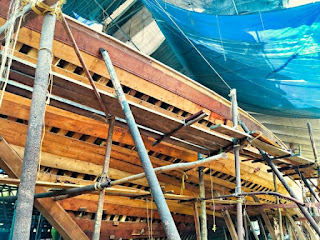 |
| handcrafted Beypore ocean going ship Uru, kerala/uasatish.com |
 |
| Beypore Uru, kerala en.wikipedia.org/wiki/Uru |
Among the Indian states, Kerala is known for its distinct and unit Hindu temple architecture, fine-arts and dances, martial arts, etc. They all highlight the native -, imaginative and improvised features that make them stand apart. Kerala hs a long coastal area and is equally popular for its old-style ship building techniques. Beypore Uru and kettuvallam - boat houses are quite well known across India and west Asia. This post is about Beypore Uru- sturdy ocean going wooden ships. Often called Dhows by the Arabs and they, ultimately, became the traditional Arabian trading vessels. They shifted the ship-building yards to beypore for reasons of availability of skilled workers and rich quality wood needed for durable ocean going ships.
.jpg) |
| Beypore Uru made from quality wood, Kerala. thehindu.com |
 |
| Beypore Uru, Kerala. onmanorama.com |
Nestled in a serene environment on the banks of the Chaliyar River Beypore is synonymous with the majestic Beypore Uru. Here, the old ethos of shipbuilding are still carefully nurtured and being kept alive
What is called the ship of Arabian dreams, Uru is an integral part of the traditional ship building culture of Kerala, that has been alive on these shores for the last 1500 years despite the advent of modern ship building methods. Why is it popular even now? It is a wooden dhow (ship / sailing boat / sailing vessel) handcrafted by well trained and skilled artisans and carpenters in Beypore, Kerala. Their families are engaged in this ship-building business for centuries. The ship builders do not make any compromise on the quality of ships and the Beypore Urus are purely made of premium wood, without using any modern techniques. Their line of approach in this fast, modern world may stagger our imagination. What is surprising is the cost of boats is not prohibitive and Centuries ago sturdy ocean going wooden ships -Uru handcrafted on the Malabar coast had sailed across the Indian ocean and Arabian sea transporting spices and clothes from this region.
About 20 to 30 artisans and carpenters form a team and take as much as 90 days to finish a full-fledged boat. The source the needed raw materials like quality teak wood, etc from Kozhikode city and neighboring places. Known for a centre for shipbuilding since the first century AD, Beypore witnessed rapid expansion under the East India Company in the early nineteenth century. As a matter of fact this place witnessed active ocean trade from ancient time and rapid expansion took place in the late medieval times primarily because of spices and clothes. .Being one of the ancient ports in Kerala that had trade relations with Middle Eastern countries.the Bepore area was visited by Arabs, Chinese and Europeans who were mercantile exporters and importers. So ship building activities were peak and the old ethos of shipbuilding in Beypore still permeates here.
As old as the beginnings of India’s maritime trade with Mesopotamia. Beypore was the largest handi crafted boat - Uru or the wooden dhow in the world. The outskirts of Kozhikode saw the heyday when the spice trade on the coastal Malabar was at its peak. .
Several crafting yards with sheds are on the banks of the the Chaliyar river and the hereditary craftsmen's ingenuity and expertise in old ship building techniques keep the old tradition alive for over a millennium. Surprisingly, the traditional ship building methods without any modern machinery native to this place so far have kept the use of modern machinery at bay.
 |
| Beypore, Kerala Uru ship building heritagehackathon.weebly.com |
The following facts are quite fascinating and worth mentioning about Uru making: .
01. Uru making iis native to Beypore (northern Kerala), close to Kozhikode and the required raw materials are sourced locally upon ascertaining their quality.
 |
| Dynamics of Buoyance in ship building. en.wikipedia.org |
https://en.wikipedia.org/wiki/Uru
https://www.onmanorama.com/videos/travel/kerala/2018/07/18/beypore-uru.html
.jfif)



.jfif)




